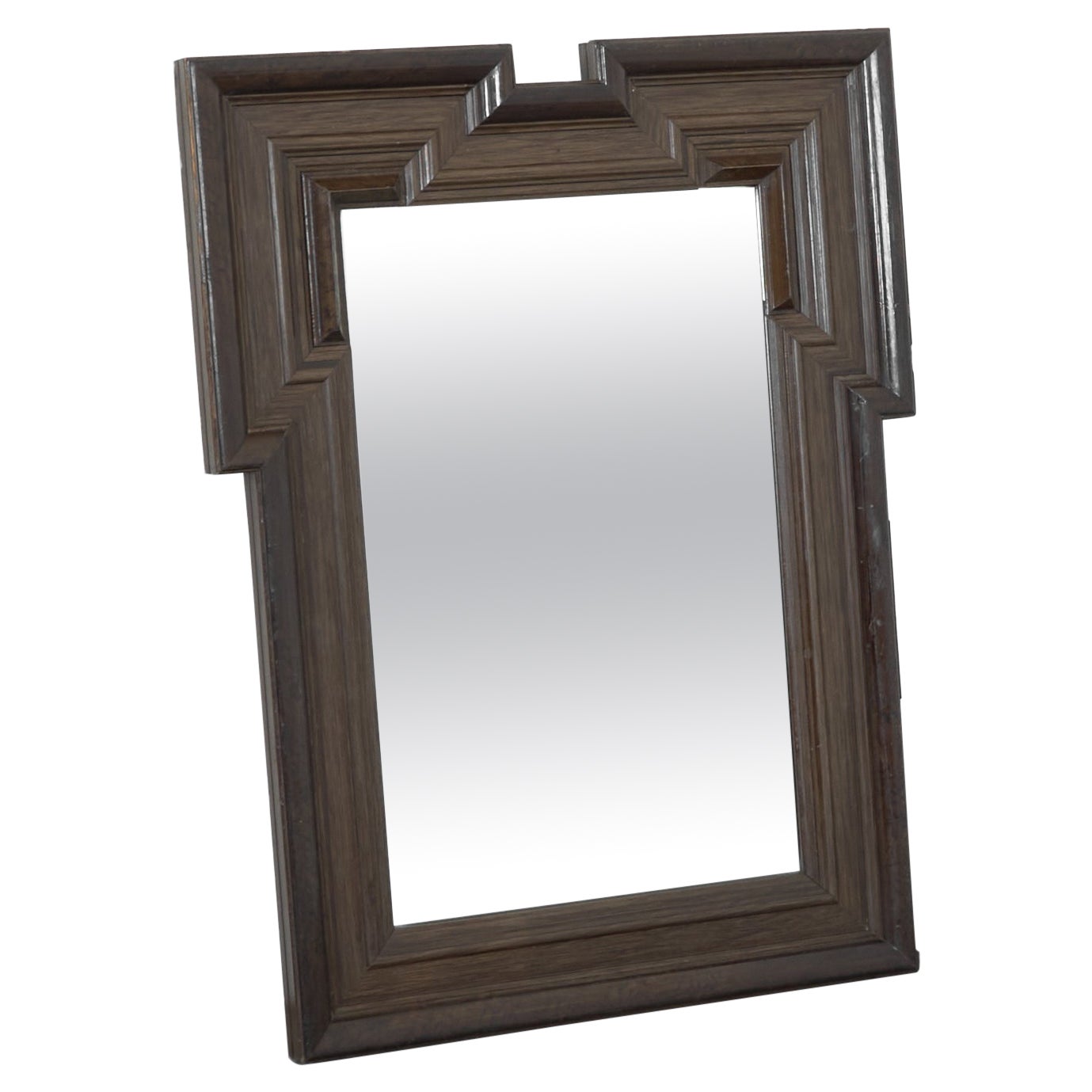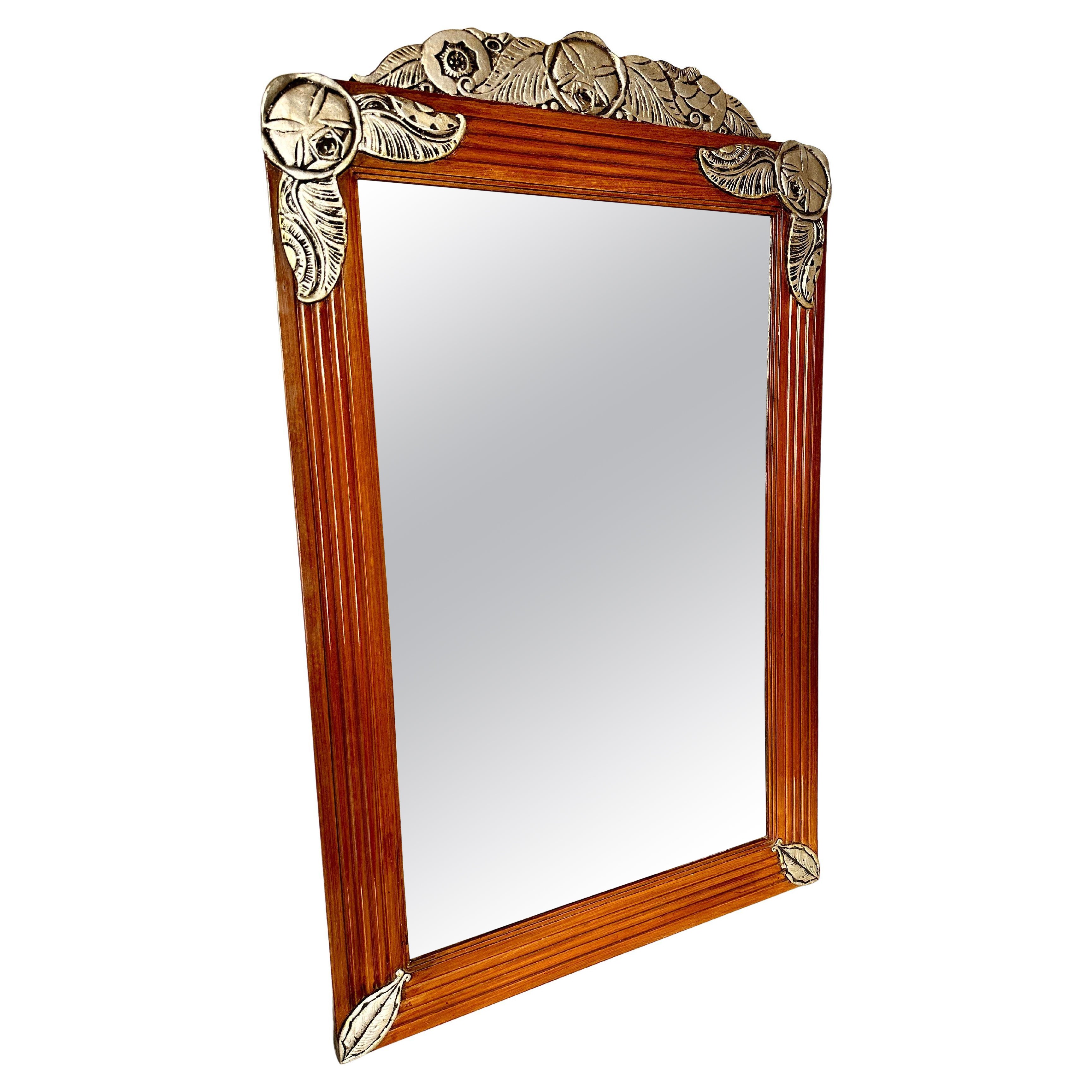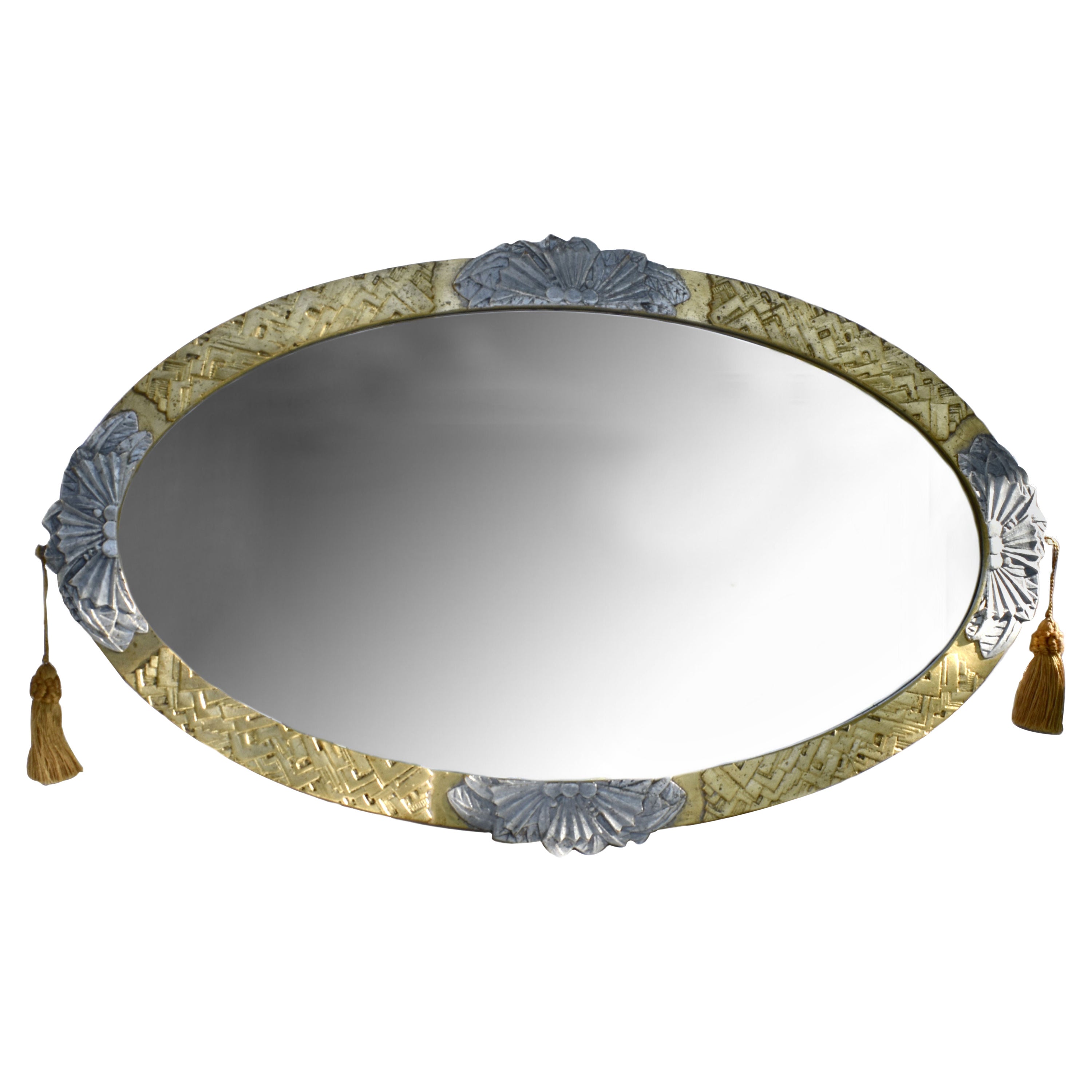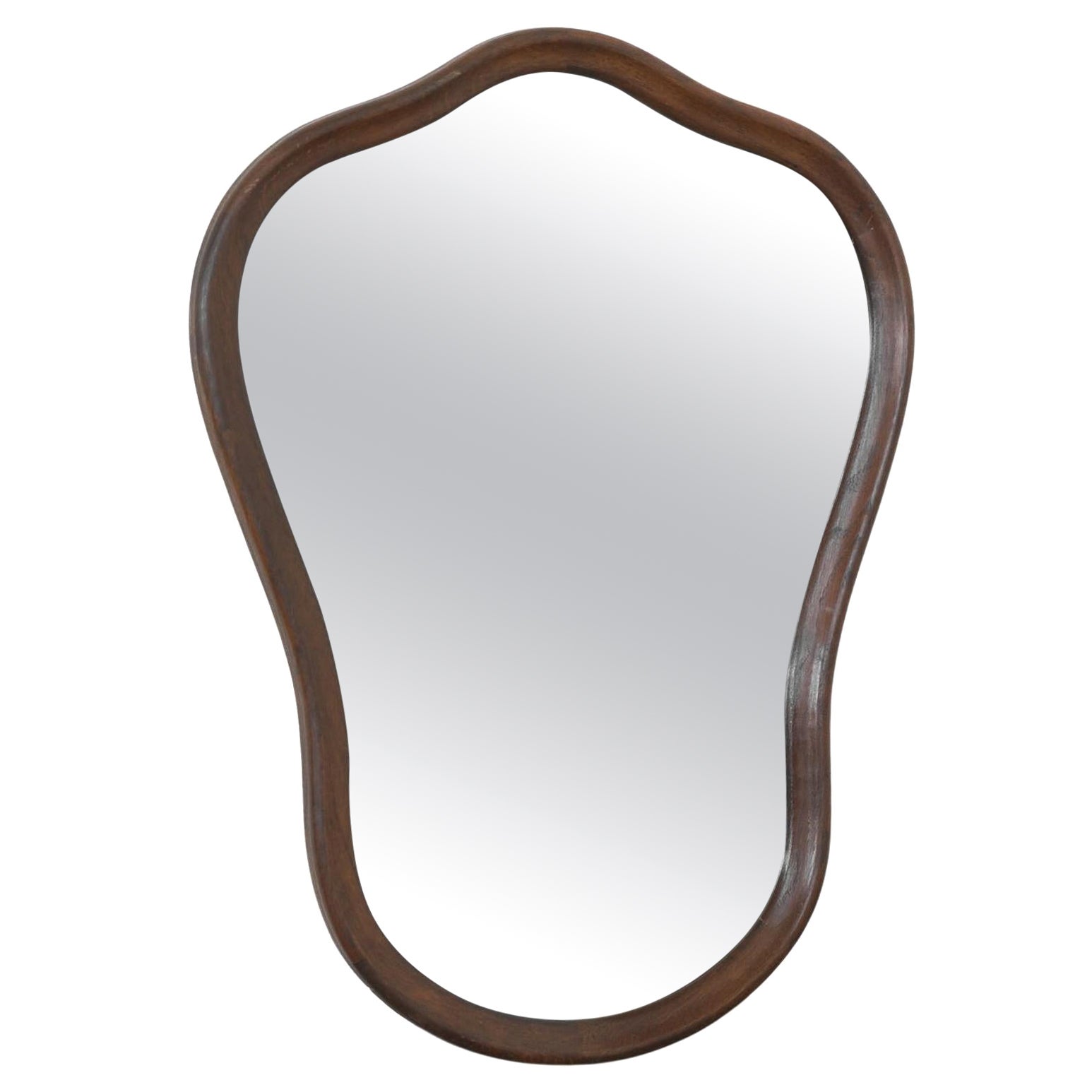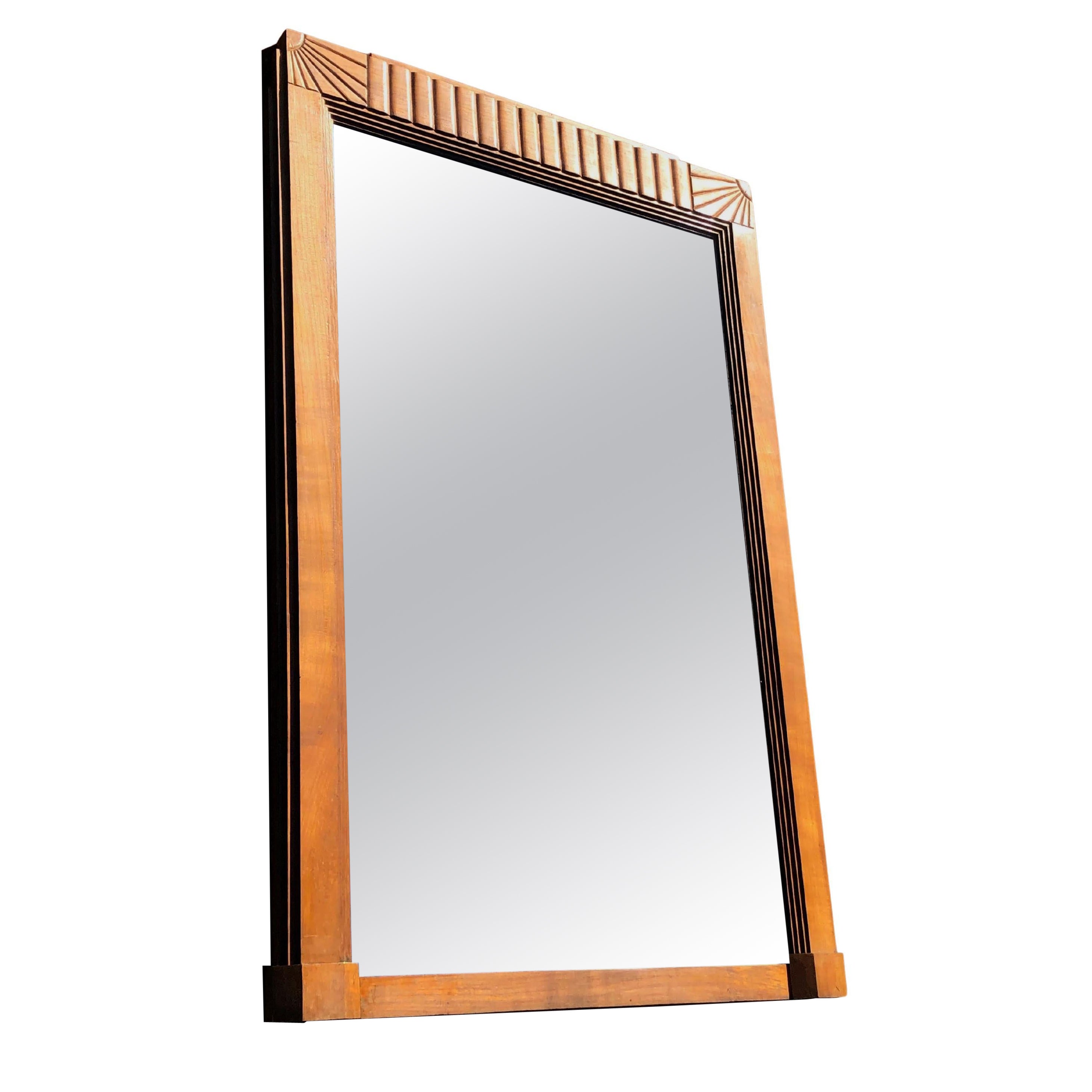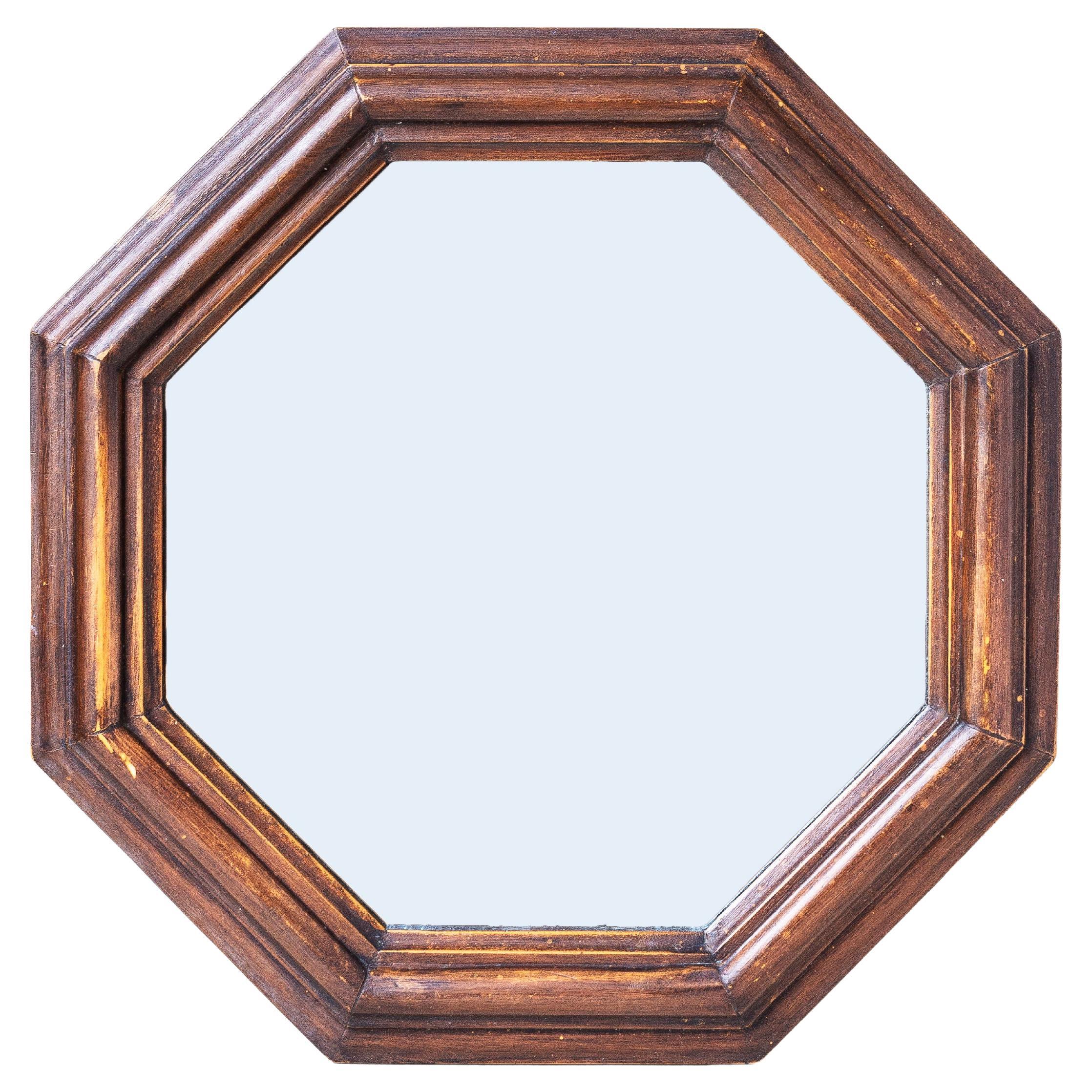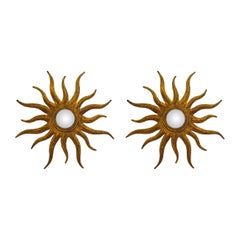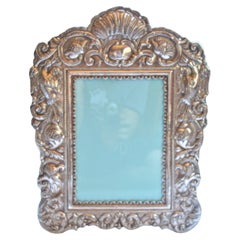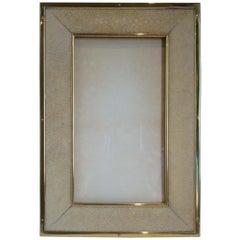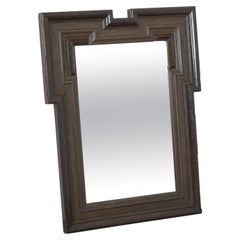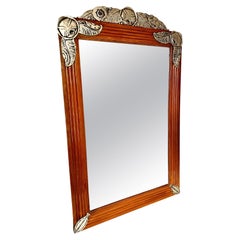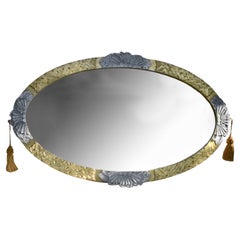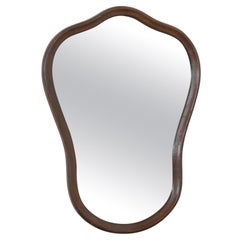Items Similar to Art Deco Painted Wood Mirror by Albert Binquet, ca 1921
Want more images or videos?
Request additional images or videos from the seller
1 of 15
Art Deco Painted Wood Mirror by Albert Binquet, ca 1921
$2,040
£1,543.96
€1,772.78
CA$2,906.15
A$3,151.79
CHF 1,655.44
MX$38,284.01
NOK 20,715.20
SEK 19,504.51
DKK 13,235.02
About the Item
Albert Binquet
Hand mirror, circa 1921
Made of wood, painted in ivory color, representing a stylized mask, the eyebrows and outer edges of the eyes underlined with black paint
Measures: Height: 24 cm. (91/2 in.) ; Width: 14 cm. (51/2 in.)
Signed in reverse A.BINQUET
Size of the mirror without the stand: 24 cm high, by 14.2 cm wide, by 1.5 cm depth.
A PAINTED WOOD MIRROR BY ALBERT BINQUET, CIRCA 1921
Subsequent to completion of his training in Barcelona, Albert Binquet, a native of Bordeaux, who trained at the Fine Art School, returned to France and collaborated with Émile-Jacques Ruhlmann to create certain sculptural reliefs for furniture, and for Robert Mallet-Stevens, a neo-Antique mask to ornament a fountain.
Inspired by a Mycenaean mask, Binquet designed the model of mirror for Michel Bufet & Bureau, company M.A.M (Meubles Artistiques Modernes), exhibited at the 12th Salon des Artistes Décorateurs, 1921.
We have specialized in the sale of Art Deco and Art Nouveau and Vintage styles since 1995. If you have any questions we are at your disposal. Pushing the button that reads 'View All From Seller'. And you can see more objects to the style for sale. Why are there so many antiques in Argentina?
In the 1880 – 1940 there was a grate wave of immigration encouraged by the periods of war that were taking place. 1st World War took place between 1914 and 1918 2nd World War took place between 1939 and 1945 The immigrants options were New York or Buenos Aires. Tickets were cheap and in Buenos Aires they were welcomed with open arms, as it was a country where everything was still to be done. Argentina was the country of new opportunities, labour was needed and religious freedom was assured, in many cases the of the family travel first until they were settled and then the rest of the family members join them. In the immigrant museum “Ellis Island Immigrant Building” in New York you can se the promotional posters of the boats that would take them to a new life. Between the years 1895 and 1896, Argentina had the highest DGP (gross domestic product) per capita in the world according to the Maddison Historical Statistics index, this situation arose due to the large amount of food being exported to European countries, which were at war. The Argentinean ships left the port of Buenos Aires with food, but they returned with furniture, clothes and construction elements, (it´s common to see this the old buildings of the historic neighbourhood of San Telmo, the beams with the inscription “Made in England)”, as well as many markets that were built in Buenos Aires, such us the San Telmo Market, whose structure was brought by ship and afterwards assembled in 900 Defensa Street. With the great influence of European immigrants living in the country, the children of the upper classes travelled to study in France, resulting in the inauguration of “La Maison Argentinienne”, on 27th of June 1928, in the international city of Paris, which hosted many Argentinians that were studying in Frace. It´s the fourth house to be built after France, Canada and Belgium, being the first Spanish-speaking one. Still in place today (17 Bd Jourdan, 75014, Paris, France). Many of the children of these wealthy families who attended international art exhibitions, museums and art courses abroad, took a keen interest in the European style. This is why Buenos Aires was at the time referred as “The Paris of South America”. Between the years 1890 and 1920 more than a hundred Palaces were built on Alvear Avenue the most exclusive avenue in Buenos Aires. Today some of these palaces have been transformed into museums, hotels and embassies. In the year 1936, the Kavanagh building was inaugurated, it was the tallest reinforced concrete building in South America. During 1994 the American Society of Civil Engineers distinguished it as an “international engineering milestone”, and it´s now considered a World Heritage of Modern Architecture. At the time was common to hire foreign architects such as Le Corbusier, who visited Buenos Aires/Argentina in 1929 and in 1948 he drew up the blueprints for a house built in La Plata City (which was declared a World Heritage Site). In 1947, the Hungarian architect Marcelo Breuer designed “Parador Ariston” in the seaside city of Mar del Plata. After an Argentinean student at Harvard University convinced him to come to Argentina. He worked on an urban development project in the Casa Amarilla, area of La Boca. The Ukrainian architect, Vladimiro Acosta, arrives in Argentina in 1928 and worked as an architect until que moved to Brazil. Antonio Bonet, a Spanish architect who worked with Le Corbusier in Paris, arrives in Argentina in 1937, where he carried out several architectural works and in 1938 designs the well-known BFK chair. Andres Kálnay, of Hungarian origin, made around 120 architectural masterpieces, among which the former Munich brewery stands out, he even made the furniture’s design. The German architect, Walter Gropius, director of the Bauhaus, lived in Argentina, where he wrote articles for “Sur” magazine and founded in Buenos Aires, an architectural firm with Franz Möller, who was also an architect, where he built two houses. At the same time several famous designers decided to immigrate to Argentina, among them we can find the well-known French designer, Jean-Michel Frank, who arrived in the country in 1940 and also worked for the Rockefeller family. Special pieces were made, which were sold exclusively in the country, such as the well-known German company “WMF”, who sold their products by catalogue, which were chosen by the ladies of high society in the list of wedding gifts, as well as the pieces designed by Christofle. The Swiss sculptor Alberto Giacometti, made special pieces for Argentinean mansions. In 1904 the first Jansen branch outside Paris was established in Buenos Aires, as the Argentinean clientele demanded a large amount of furniture, from the end of the 19th century to the mid-20th century. In 1970, the brand Rigolleau Argentina made pieces authorised by Lalique. The brands Maple and Thompson also set up shop in the country. The French plastic artist, Marcel Duchamp moved to Argentina in 1918-1919. Glass signed Gallé, Charder, Leverre, Schneider, Muller and other French firms. They were bought in flower shops and were given to ladies with beautiful floral arrangements. Some furniture manufacturers travelled to international fairs and bough the patterns to produce the furniture in Argentina, such as the furniture firm Englander and Bonta, who bought the patterns in Italy. It is worth mentioning that in Argentina we have the largest community of Italians outside of Italy, as it is estimated that 70 percent of the inhabitants have at least one Italian descendant, followed by Spanish immigrants. The most Important furniture stores in Argentina: Comte is founded in 1934 (under the direct management of Jean Michel Frank in 1940). Nordiska (Swedish company established in 1934). Churba in 1960, a company that brought foreign designers to present their furniture in the country: Denmark: (Arne Jacobsen, Finn Juhl, Bender Madsen, Ejner Larsen, Poul Kjaerholm, Hans Wegner) Sweden: (Hans Agne Jakobsson, Gustavsberg) United States: (Herman Miller) Finland: (Lisa Johansson, Folke Arstrom, Tapio Wirkkala, Alvar Aalto, Timo Sarpaneva) Swedish Factory: (Orrefors) Italy: (Littala, Vico Magistretti, Emma Gismondi, Gae Aulenti, Angelo Mangiarotti, Elio Martinelli, Gianna Celada, Angelo Mangiarotti, Mario Bellini, Carlo Scarpa) Finland: (Olivia Toikka) Plata Lappas (Lappas Silver): a goldsmith shop founded in 1887 in Argentina by Alcibiades Lappas of Greek origin. In 2019, in Argentina took place “the Art Deco world congress” . Argentina currently has more than 100 Art Deco buildings and another 90 Art Nouveau buildings throughout the city of Buenos Aires. Argentina is a country that has not been involved in many wars, which is why it has been a refuge for works of art and antiques from different periods of time, unlike European countries. That is way many collectors, museums and antique dealers from all over the world visit it, you should not miss the opportunity to visit this great country.
- Creator:Albert Binquet (Artist)
- Dimensions:Height: 16.15 in (41 cm)Width: 5.6 in (14.2 cm)Depth: 0.6 in (1.5 cm)
- Style:Art Deco (In the Style Of)
- Materials and Techniques:
- Place of Origin:
- Period:
- Date of Manufacture:1920s
- Condition:Wear consistent with age and use. Minor losses.
- Seller Location:Buenos Aires, AR
- Reference Number:1stDibs: LU2027324265552
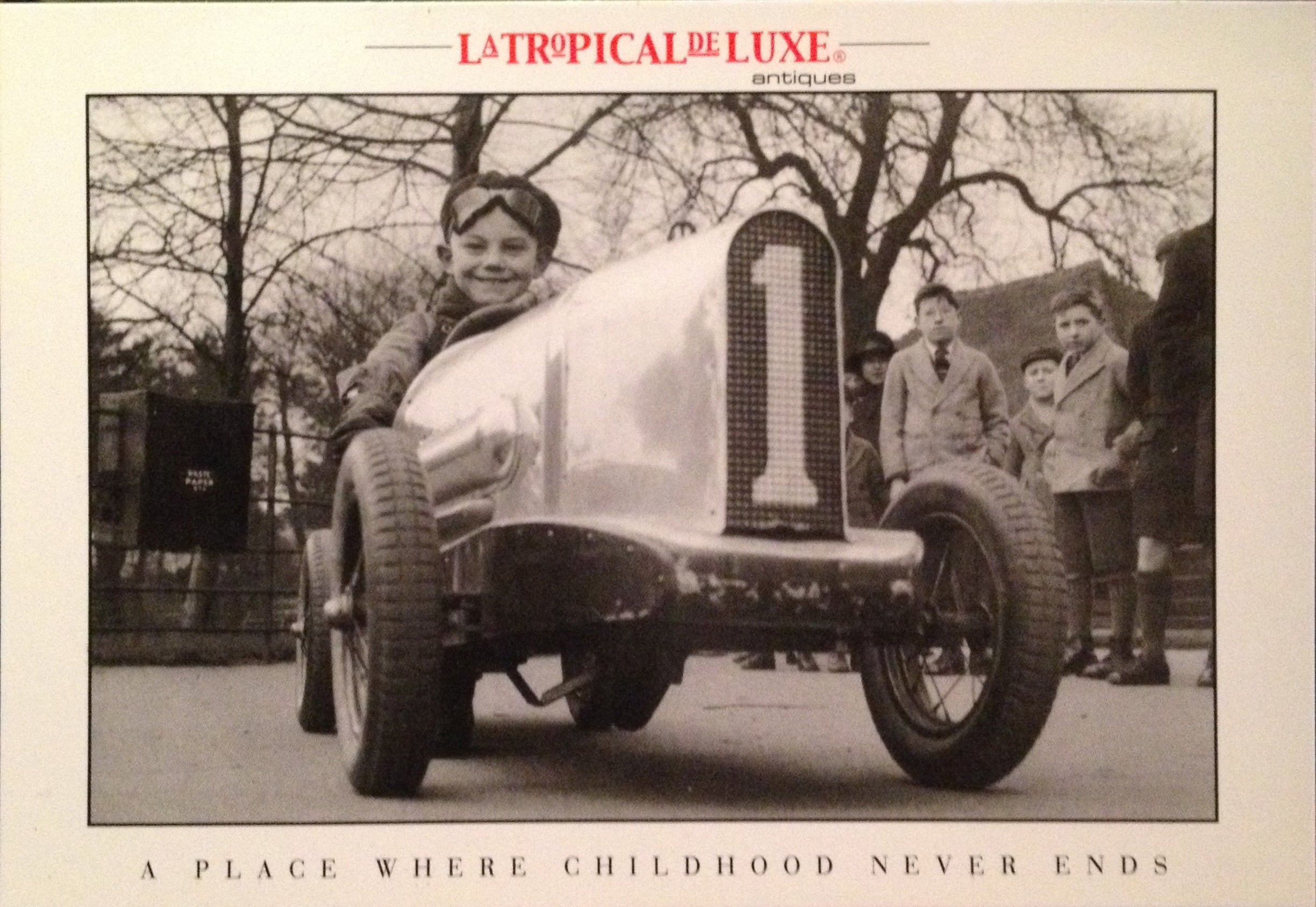
About the Seller
4.9
Vetted Professional Seller
Every seller passes strict standards for authenticity and reliability
Established in 2002
1stDibs seller since 2016
324 sales on 1stDibs
Typical response time: <1 hour
- ShippingRetrieving quote...Shipping from: Buenos Aires, Argentina
- Return Policy
Authenticity Guarantee
In the unlikely event there’s an issue with an item’s authenticity, contact us within 1 year for a full refund. DetailsMoney-Back Guarantee
If your item is not as described, is damaged in transit, or does not arrive, contact us within 7 days for a full refund. Details24-Hour Cancellation
You have a 24-hour grace period in which to reconsider your purchase, with no questions asked.Vetted Professional Sellers
Our world-class sellers must adhere to strict standards for service and quality, maintaining the integrity of our listings.Price-Match Guarantee
If you find that a seller listed the same item for a lower price elsewhere, we’ll match it.Trusted Global Delivery
Our best-in-class carrier network provides specialized shipping options worldwide, including custom delivery.More From This Seller
View AllPair of Early 20th Century Giltmetal Sunburst Mirrors. France
Located in Buenos Aires, Olivos
Pair of Early 20th Century Giltmetal Sunburst Mirrors. France.
French Giltmetal sunburst mirrors 20 inch wide, france, 1930s-1940.
Beautiful pair of sunburst mirrors.
Lovely age pat...
Category
20th Century French Mid-Century Modern Sunburst Mirrors
Materials
Metal
South American Sterling Silver Hand Made Embossed Picture Frame / Mirror 1940´s
Located in Buenos Aires, Olivos
South American sterling silver hand made / Embossed picture frame / mirror 1940´s. Marked hand-made and 925 (it´s the sterling mark in south america).
Perfect for any Mexican Style h...
Category
Mid-20th Century Argentine Spanish Colonial Sterling Silver
Materials
Silver, Sterling Silver
Art Nouveau - Art & Craft Sterling Silver Enamel Photograph Frame, Cymric 1903
By Liberty & Co., Archibald Knox, William Hair Haseler
Located in Buenos Aires, Olivos
Art Nouveau - Art & craft sterling silver enamel photograph frame - William Hutton & Sons 1903.
William Hutton & Sons silver and enamel square photo frame...
Category
Early 20th Century British Arts and Crafts Sterling Silver
Materials
Sterling Silver, Enamel
Art Deco Leather Photo / Picture / Photograph Frame, c. 1925
Located in Buenos Aires, Olivos
Art Deco Leather Foto / Picture / Photograph frame, c. 1925.
20th century vintage leather (Galuchat) leather photo frame.
Very well made rectangular leather frame with gilt bronze bo...
Category
Early 20th Century French Art Deco Picture Frames
Materials
Leather
Art Deco Andre Arbus Parchment Leather and Mirror Side Tables, France, 1930s
By André Arbus
Located in Buenos Aires, Olivos
Lovely pair of sofa side tables. Wood covered with parchment leather. Original mirror on the top. Made in France, 1930s.
Category
Vintage 1930s French Art Deco Side Tables
Materials
Brass
Art Deco Bakelite Set of Photograph Frames, Set of Three
Located in Buenos Aires, Olivos
Very nice group of three bakelite picture frames. Art Deco style. The rectangulars measure 13.2 cm by 9.8 cm and the round one 13.2 cm diameter.
Very good conditions.
We have specia...
Category
Mid-20th Century French Art Deco Picture Frames
Materials
Bakelite
You May Also Like
Art Deco Mirror in Carved Wood 1930s
Located in Tilburg, NL
Art Deco Mirror in Carved Wood 1930s.
Elegant art deco wall mirror in carved wood. Great period art deco piece with a very elegant and timeless yet distinct shape. Suitable for vari...
Category
Early 20th Century European Art Deco Wall Mirrors
Materials
Wood
Large French Art Deco Fruitwood Mirror
Located in London, GB
Large French Art Deco fruitwood mirror.
Gorgeous 1930s mirror with reeded frame and gilded silver decorative reliefs. In excellent condition with very light and attractive foxing.
...
Category
Vintage 1920s French Art Deco Wall Mirrors
Materials
Cherry
Art Deco French Wall Mirror, c1930s
Located in Devon, England
Original 1930's French Art Deco wall mirror with geometric and floral motif details. Lovely shape and design and typical colourway for these mirrors. The Mirror itself is in great co...
Category
Mid-20th Century French Art Deco Wall Mirrors
Materials
Mirror, Boxwood
Art Deco Sculptural Mirror in Wood, 1930s
Located in Tilburg, NL
Art Deco Sculptural Mirror in Wood, 1930s.
Beautiful shaped art deco mirror in wood made in the 1930s. Sculptural design with flowing and elegant sha...
Category
Early 20th Century European Art Deco Wall Mirrors
Materials
Wood
An important ART-DECO Architectural MODERNIST Wall MIRROR, France 1930
Located in PARIS, FR
An important rectangular wall mirror, Art-Deco, Modernist, Bauhaus. A beautiful, sculptural, bright wood frame is surrounding an authentic silver mirror from the early thirties. The ...
Category
Vintage 1930s French Art Deco Wall Mirrors
Materials
Mirror, Wood
Art Deco Wooden Wall Mirror, France 1940s
Located in ROUEN, Normandie
Art Deco Wooden Wall Mirror, France 1940s.
This Art Deco hexagonal mirror from the 1940s is an elegant and minimal piece of vintage decor.
The mirror features a wooden frame with ...
Category
Mid-20th Century European Art Deco Wall Mirrors
Materials
Wood, Fruitwood, Nutwood
More Ways To Browse
1960 Vintage Early American Furniture
Art Deco Mirrored End Tables
Italian Art Antique Painted Religious
Albert Wood
Fountain Mask
Mirrored Gilt Vanity
Antique Shaving Table
Art Nouveau Bronze Mirror
Antique Silver Vanity Mirror
Antique Silver Table Mirror
Antique Swing Mirror
Antique Victorian Vanity Mirror
Toilet Table
Silver Dressing Table Mirrors
Table Mirror Folded
Georgian Dressing Table
Rotating Vintage Mirror
Antique Shaving
